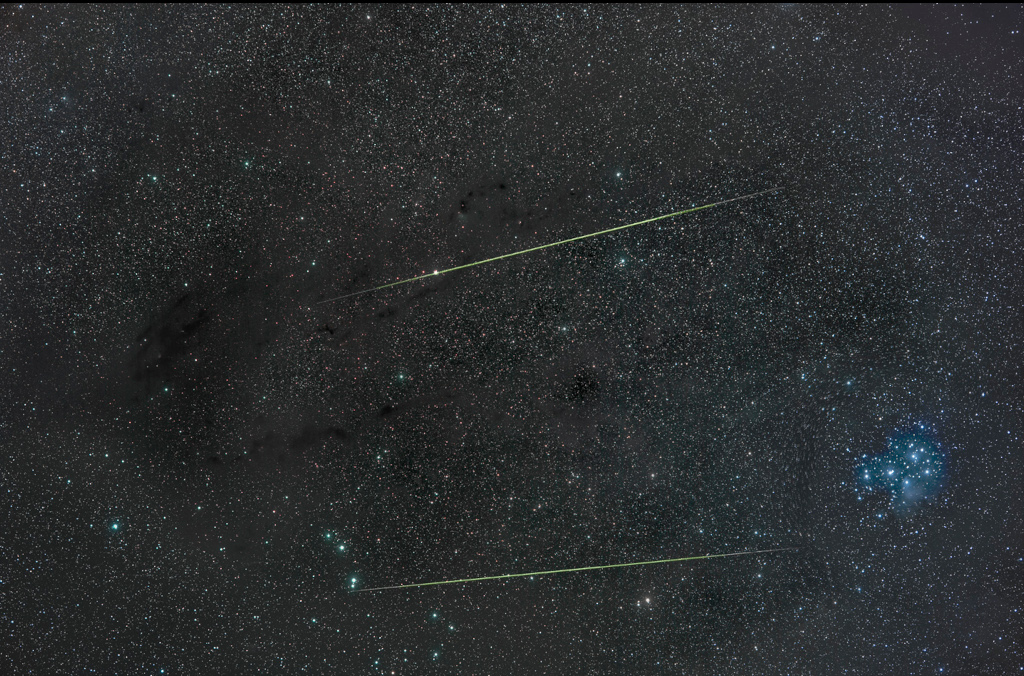안녕하세요!
디지탈노다지입니다.
미국 NASA에서 제공하는 오늘의 우주 사진을 공유합니다.
어떤 우주의 모습을 비춰줄까요?
우선, 사진부터 감상하시죠! 이 멋진 사진의 제목은 Orionids in Taurus 입니다.
NASA에서 공식적으로 제공한 설명을 보시죠. History's first known periodic comet, Comet Halley (1P/Halley), returns to the inner Solar System every 76 years or so. The famous comet made its last appearance to the naked-eye in 1986. But dusty debris from Comet Halley can be seen raining through planet Earth's skies twice a year during two annual meteor showers, the Eta Aquarids in May and the Orionids in October. In fact, an unhurried series of exposures captured these two bright meteors, vaporizing bits of Halley dust, during the early morning hours of October 23 against a starry background along the Taurus molecular cloud. Impacting the atmosphere at about 66 kilometers per second their greenish streaks point back to the shower's radiant just north of Orion's bright star Betelgeuse off the lower left side of the frame. The familiar Pleiades star cluster anchors the dusty celestial scene at the right. 역사상 최초로 알려진 주기 혜성 핼리 혜성(1P/Halley)은 약 76년마다 태양계 내부로 돌아온다. 그 유명한 혜성은 1986년에 맨눈으로 마지막 모습을 드러냈다. 하지만 핼리 혜성의 먼지 파편은 매년 5월 에타 물병자리와 10월 오리온자리와 같은 두 차례의 유성우 동안 지구의 하늘을 통해 비가 내리는 것을 볼 수 있다. 실제로 10월 23일 새벽, 황소자리 분자 구름을 따라 별을 배경으로 핼리 먼지의 일부를 기화시키는 이 두 개의 밝은 유성들을 성급하게 연속적으로 포착했다. 대기에 초당 약 66킬로미터의 영향을 미치는 이들의 녹색 줄무늬는 프레임의 왼쪽 아래에서 오리온자리의 밝은 별 베텔게우스 바로 북쪽에서 복사되는 소나기를 가리키고 있다. 친숙한 플레이아데스 성단은 오른쪽에 먼지투성이의 천체 장면을 고정시킨다. 우주의 다양한 모습은 아름답습니다~
그리고 광활하며 거대합니다. 형형색색 변화하며 살아있는 듯한 느낌을 주네요~ 가볼 수는 없지만 이렇게 사진으로 볼 수 있어서 좋네요!
디지탈노다지는 더 좋은 사진과 함께 돌아오겠습니다,
남은 하루도 행복하세요~ 
'자동화정보' 카테고리의 다른 글
| The Ghosts of Gamma Cas(2023-10-28)NASA 우주사진 (0) | 2023.10.28 |
|---|---|
| Encke and the Tadpoles(2023-10-27)NASA 우주사진 (1) | 2023.10.27 |
| Gone in 60 Seconds: A Green Flash Sunset(2023-10-25)NASA 우주사진 (0) | 2023.10.25 |
| Arp 87: Merging Galaxies from Hubble(2023-10-24)NASA 우주사진 (1) | 2023.10.24 |
| Moon Io from Spacecraft Juno(2023-10-23)NASA 우주사진 (0) | 2023.10.23 |